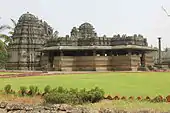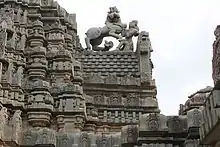Kedareshvara Temple, Balligavi
The Kedareshvara temple (also spelt Kedareshwara or Kedaresvara) is located in the town of Balligavi (known variously in ancient inscriptions as Belagami, Belligave, Ballagamve and Ballipura), near Shikaripura in the Shimoga district of Karnataka state, India. Dotted with centres of learning (agrahara), Balligavi was an important city during the 11th - 12th century Western Chalukya rule. The term Anadi Rajadhani (ancient capital) used in medieval inscriptions to describe this town tells a tale of great antiquity.[1][2] Art historian Adam Hardy classifies the style involved in the construction of the temple as "Later Chalukya, non mainstream, relatively close to mainstream". He dates the temple to late 11th century, with inscriptional evidence of additions made up to 1131, by the Hoysalas during their control over the region. The building material used is soapstone. The Archaeological Survey of India classifies the style of architecture as distinctly Hoysala.[1][2] The Hoysala ruling family was during this period a powerful feudatory of the imperial Western Chalukya Empire, gaining the trappings of independence only from the period of King Vishnuvardhana (1108-1152 A.D).[3][4][5] The temple is protected as a monument of national importance by the Archaeological Survey of India.[6]
Kedareshvara Temple | |
|---|---|
Hindu temple | |
_at_Balligavi_1.JPG.webp) Kedareshvara temple (1070) at Balligavi in Shimoga district | |
| Country | |
| State | Karnataka |
| District | Shimoga District |
| Languages | |
| • Official | Kannada |
| Time zone | UTC+5:30 (IST) |
Deity
The cella (garbhagriha) in the shrines to the west and south contain the Shivalinga (the universal symbol of the Hindu god Shiva) and the cella to the north has an image of the god Vishnu.[1] The temple is connected with the legend of demon Bali according to some lithic records.[1] In its heyday, the temple attracted a large number of followers of the Kalamukha sect of Shaivism. A four faced image of the god Brahma, which at one time may have been inside the temple, is on display in a museum within the temple complex.[1]
Temple plan

_at_Balligavi.JPG.webp)

The temple is in trikuta style (three shrined, each with a superstructure or shikhara[7]) with the shrines facing east, north and south. The western shrine has a vestibule where as the other two shrines have a "half hall" (ardhamantapa). All shrines open up to a six-pillared hall called mahamantapa which is preceded by a large ornate open "gathering hall" called sabhamantapa.[1][2] The layout of the gathering hall is "staggered square" which has the effect of creating projections and recesses. Each projection of the wall has a complete "architectural articulation" (achieved by repetitive decoration).[8] The gathering hall has entrances from the north, south and eastern directions.[1]
Decoration
The outer walls of the shrines are quite austere save for the pilasters that are capped by miniature decorative towers (aedicula).[9] The superstructures over the shrines are 3-tiered (tritala arpita) vesara (combination of south and north Indian style) with the sculptural details being repeated in each tier.[1] The temple exhibits other standard features present in a Hoysala style temple: the large decorative domed roof over the tower; the kalasha on top of it (the decorative water-pot at the apex of the dome); and the Hoysala crest (emblem of the Hoysala warrior stabbing a lion) over the sukhanasi (tower over the vestibule). The dome is the largest sculptural piece in the temple with ground surface area of about 2x2 meters and is called the "helmet" or amalaka. Its shape usually follows that of the shrine (square or star shape). The tower over the vestibules of the three shrines appear as low protrusions of the main tower and is hence called the "nose".[10][11]
Notes
- "Kedareshvara Temple". Archaeological Survey of India, Bengaluru Circle. ASI Bengaluru Circle. Retrieved 16 July 2012.
- Hardy (1995), p324
- During the rule of King Vinyaditya (1047–1098), the Hoysalas established themselves as a powerful Chalukya feudatory (Chopra 2003, p151, part 1)
- Sen (1999), p498
- Foekema (1996), p14
- "Alphabetical List of Monuments - Karnataka -Bangalore, Bangalore Circle, Karnataka". Archaeological Survey of India, Government of India. Indira Gandhi National Center for the Arts. Retrieved 14 July 2012.
- Foekema (1996), p25
- Foekema (1996), pp 21-22
- Foekema (1996), p28
- Foekema (1996), p22
- Foekema (1996), p27
Gallery
 About Kedaresvara temple, Balligavi
About Kedaresvara temple, Balligavi_at_Balligavi.JPG.webp) A frontal view displays the staggered square layout of mantapa (hall) in Kedareshvara temple at Balligavi
A frontal view displays the staggered square layout of mantapa (hall) in Kedareshvara temple at Balligavi Ornate bay ceiling in Kedaresvhara temple at Balligavi
Ornate bay ceiling in Kedaresvhara temple at Balligavi_in_Kedareshvara_temple_at_Balligavi.JPG.webp) A Sati stone (satigal) with old Kannada inscription of 1206 in Kedareshvara temple at Balligavi
A Sati stone (satigal) with old Kannada inscription of 1206 in Kedareshvara temple at Balligavi Old Kannada inscription (1161) of Southern Kalachuri King Bijjala at the Kedareshvara temple at Balligavi
Old Kannada inscription (1161) of Southern Kalachuri King Bijjala at the Kedareshvara temple at Balligavi_in_Kedareshvara_temple_at_Balligavi_3.JPG.webp) Hero stone (virgal) with old Kannada inscription of 1263 from the rule of Yadava King Ramachandra in Kedareshvara temple at Balligavi
Hero stone (virgal) with old Kannada inscription of 1263 from the rule of Yadava King Ramachandra in Kedareshvara temple at Balligavi_sculpture_on_vesara_tower_in_the_Kedareshvara_temple_at_Balligavi.jpg.webp) Kirtimukha (demon face) on shikhara (tower) of Kedareshvara temple at Balligavi
Kirtimukha (demon face) on shikhara (tower) of Kedareshvara temple at Balligavi_Brahma_at_the_museum_in_Kedareshwara_temple_complex_at_Balligavi.jpg.webp) Chaturmukha Brahma image at museum on temple premises
Chaturmukha Brahma image at museum on temple premises Dev Naga (god snake) image at museum on temple premises
Dev Naga (god snake) image at museum on temple premises Old Kannada inscription
Old Kannada inscription Museum at Kedareshvara temple premises, Balligavi
Museum at Kedareshvara temple premises, Balligavi
References
| Wikimedia Commons has media related to Kedareshvara Temple, Balligavi. |
- "Kedaresvara Temple". Archaeological Survey of India, Bengaluru Circle. ASI Bengaluru Circle. Retrieved 14 July 2012.
- Adam Hardy, Indian Temple Architecture: Form and Transformation : the Karṇāṭa Drāviḍa Tradition, 7th to 13th Centuries, Abhinav, 1995 ISBN 81-7017-312-4.
- "Alphabetical List of Monuments - Karnataka -Bangalore, Bangalore Circle, Karnataka". Archaeological Survey of India, Government of India. Indira Gandhi National Center for the Arts. Retrieved 12 July 2012.
- Chopra, P.N.; Ravindran, T.K.; Subrahmanian, N (2003) [2003]. History of South India (Ancient, Medieval and Modern) Part 1. New Delhi: Chand Publications. ISBN 81-219-0153-7.
- Sen, Sailendra Nath (1999) [1999]. Ancient Indian History and Civilization. New Age Publishers. ISBN 81-224-1198-3.
- Gerard Foekema, A Complete Guide to Hoysala Temples, Abhinav, 1996 ISBN 81-7017-345-0
